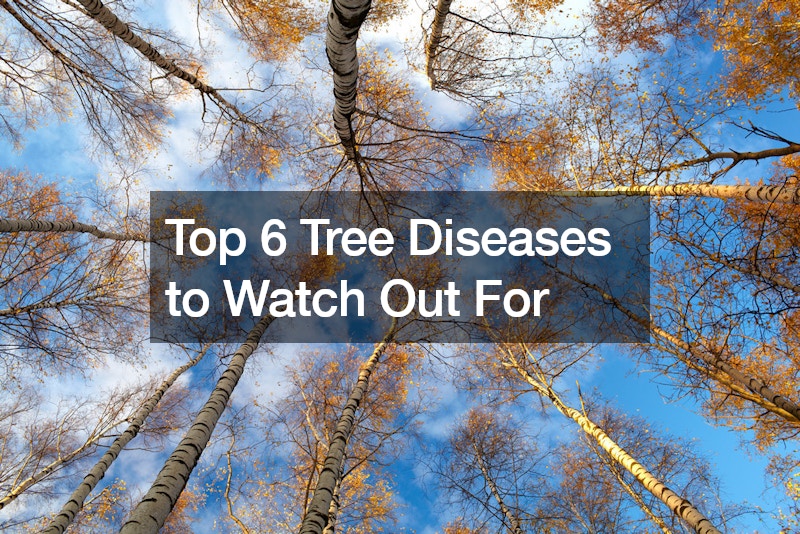Trees enhance our landscapes and contribute significantly to our environment. However, they are susceptible to various diseases that can affect their health and beauty. Understanding these common tree diseases and their symptoms can help in timely intervention and prevention. Here are six notable tree diseases to be aware of:
1. Anthracnose
Anthracnose is a fungal disease that impacts both deciduous and evergreen trees. It’s particularly prevalent in areas with cool, wet weather, which creates ideal conditions for the fungus to thrive.
The disease is characterized by dark and sunken lesions on leaves, branches, and stems. In severe cases, it can cause dieback, where branches and even the main trunk may be affected. Black spots often appear on the leaves, which can spread to other parts of the tree.
To manage anthracnose, promptly remove and dispose of infected plant material to prevent the spread of fungal spores. Avoid composting affected leaves, as this can perpetuate the infection. Good air circulation around the tree can also help reduce humidity levels that favor fungal growth. While fungicides may be effective, they are more practical for small trees or shrubs, and professional application might be necessary for larger trees.
2. Bacterial Leaf Scorch
Bacterial leaf scorch primarily affects oak trees, with pin oaks being particularly vulnerable. This disease is caused by bacteria that block the xylem, the vascular system responsible for nutrient and water transport.
The disease leads to a gradual decline in tree health, causing leaves to become scorched or browned, particularly around the edges. The symptoms can appear sporadically on different parts of the tree.
Unfortunately, there is no cure for bacterial leaf scorch. Efforts should focus on keeping the tree as healthy as possible through proper watering and care. Some treatments involve injecting antibiotics into the tree, but this is expensive and generally only delays the inevitable decline.
3. Oak Leaf Blister
Oak leaf blister is a fungal disease that creates raised, blister-like spots on oak leaves. It is more common during wet, cool springs, which promote fungal growth.
Infected leaves develop yellowish or brownish raised areas, which can sometimes become concave. This can affect the overall aesthetic of the tree but generally does not cause significant harm.
Maintaining plant vigor is crucial for managing oak leaf blister. Infected leaves should be collected and disposed of properly to prevent spore spread. Fungicide applications, such as chlorothalonil, can be effective when applied in the spring as buds burst. However, professional help may be needed for large trees.
4. Shot Hole Disease
Shot hole disease affects trees in the Prunus genus, including plums, cherries, and laurels. This fungal disease is known for creating distinctive brown spots and holes on the leaves.
The disease causes brown spots that eventually drop out, leaving behind holes that resemble bullet impacts. This can lead to a decrease in leaf quality and overall tree appearance.
To combat shot hole disease, ensure adequate air circulation around the tree by pruning surrounding vegetation. Regular fungicide applications may be necessary as a preventative measure. Like other fungal diseases, managing humidity and moisture is crucial to controlling its spread.
5. Powdery Mildew
Powdery mildew is a fungal disease thriving in cool, damp conditions. It affects a variety of trees, including dogwoods, which are particularly susceptible.
The disease manifests as a white or grayish powdery substance on the leaves, particularly on new growth. It can stunt growth and reduce the tree’s overall vigor.
Good air circulation is key to preventing powdery mildew. This involves spacing trees properly and ensuring they receive adequate sunlight. Avoid overhead irrigation, which can exacerbate the problem. Resistant varieties of trees are available and should be considered to reduce susceptibility.
6. Cankers
Cankers are diseases that cause localized dead areas on tree bark. They often result from mechanical injuries or infections by various fungi and bacteria.
Cankers appear as dark, sunken areas on the bark, which can expand over time. This can lead to dieback of branches and a general decline in tree health. Some cankers, such as hypoxylon canker, chestnut blight, and cytospora, are particularly severe and can be fatal.
To prevent cankers, avoid mechanical damage to trees caused by lawnmowers or other equipment. Keeping trees healthy through proper care and maintenance can help them recover from minor canker infections. Severe cases may require professional intervention from a tree surgeon. Unfortunately, some cankers cannot be treated once established.
In Closing
Being vigilant about tree health and understanding these common diseases can help you maintain a thriving and beautiful landscape. Regular inspection, prompt action, and good horticultural practices are essential in managing tree diseases effectively. If in doubt, consulting a certified arborist can provide expert guidance and ensure the long-term health of your trees.
.





